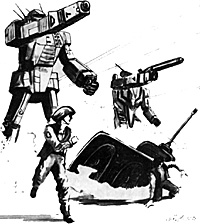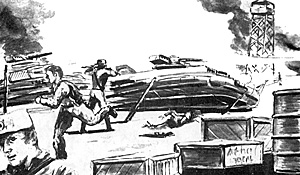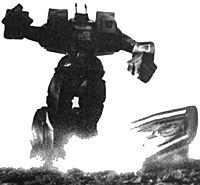
Having discussed a few of the battlefield or strategic applications of light cavalry, we should examine the tactics used in each of those applications. In the same way that applications of cavalry units have not changed much over time, neither have the tactics used by this type of unit been altered in any significant way.
The basis of all tactics employed by light cavalry platoons remains the fast hit-and-run attack, usually hitting the enemy from behind. Lightning-swift harassment raids against columns are still the primary function of cavalry troopers. It's easy to see how these quick strikes can turn the tide of a battle when each tactical application is examined individually.
Cavalry scouts have the advantage over regular scout vehicles in that they are generally better armed and armored, while hovercraft like the J. Edgar and the Harrier are as fast as, or faster than, the Swift Wind. Though it may lack the sophisticated surveillance and communications equipment of the Swift Wind, a fast hovertank has a better chance of surviving long enough to relay its information back to its unit's commander.
Generally, scout missions are performed according to a predetermined plan. The unit undertakes a wedge-shaped pattern of back and forth sweeps with its point towards the company to which the scouts are attached and its base towards the enemy's suspected position. The pattern is run working outwards from the main body of the unit. The parallel sweeps are spaced in such a way that the area covered in each sweep overlaps the area covered in the previous one. The reason for this procedure is simple. By working outwards in overlapping sweeps of increasing length, a scout stands the best chance of detecting the presence of enemy forces in his search arm.
Once an enemy has been spotted, a scout's duties are to ascertain the enemy's numbers, the composition of his forces, his relative strength, and his heading. Also, a scout should make an attemptto identify the unit and determine the presence of any notable MechWarriors. House Kurita's "Nightstalkers", for example, are one thing, but the "Black Widow Company" of "Wolf's Dragoons" with Natasha Kerensky in command is quite another matter entirely.
The disruption of communications on the high-tech 31st-century battlefield is mostly a matter of electronic countermeasures. Before a scout is able to transmit information to his unit's command post, however, he must first observe something about which to report. It a scout is spotted and driven off or destroyed before he can communicate any information, then communications have effectively been disrupted. When a cavalry screen is called upon to eliminate scouts, only a few vehicles, two or three from each cavalry platoon, are detached to pursue enemy scouts. These vehicles should attempt to flank their prey, or even circle behind him, thus cutting him off from his escape route, before actually engaging the enemy. If the enemy scout begins to run and the scout killers are unable to catch him, the defending cavalry vehicles should break off their pursuit and return to their own unit. This precaution is taken in the event that the enemy scouts were either bait for an ambush, or a decoy intended to draw off the cavalry screen.
 Unhorsed The crewmen of light cavalry vehicles frequently take to the ground when
they get caught in clashes between the armored giants.
Unhorsed The crewmen of light cavalry vehicles frequently take to the ground when
they get caught in clashes between the armored giants.
Usually, a cavalry unit's orders limit to a kilometer or less the distance a scout killer may pursue a scout. The elimination of a damaged 'Mech by cavalry vehicles often resembles a scene from a 2Oth century Western with the Indians mounted on the war ponies riding in circles around the wagon train. Light cavalry vehicles designated to handle crippled 'Mechs should make quick hit-and-run attacks, preferably striking at the enemy's rear quarter where his armor is thinnest and where he has few to no weapons. As soon as the attack has been made, the cavalry vehicle should pull back. If more than one vehicle is attacking a single damaged 'Mech, they can sandwich it between them and hammer away. !n a situation like this, it is important to remember that even a damaged 'Mech is potentially more than a match for any light cavalry vehicles. If necessary, a damaged 'Mech can be bypassed for the cavalry's own 'Mech units to eliminate.
If the wounded unit is a broken infantry platoon, even light cavalry vehicles will be able to take care of it. The most common means of dealing with broken infantry is the classic overrun. The cavalry unit simply charges straight through the withdrawing or grounded infantry. The gunners may fire at will.
As mentioned earlier, it is possible for an experienced (or merely clever) cavalry officer to use his command to turn the broken enemy units back into their own lines, creating a great deal of confusion in the enemy ranks. This can be accomplished by moving behind the main enemy lines and striking directly at the front facing of a fleeing unit. When the enemy turns away from this new threat, the light cavalry unit simply herds them back into their own lines, like a sheep dog guiding its flock. As with any other tactic which takes men behind enemy lines, the cavalry troopers should be alert for a possible counterattack by the enemy's reserves or their light cavalry.
When assaulting a supply depot or column, the purpose of the raid should always be kept in mind. Often, the temptation to engage the enemy units defending those stores is very strong. If a raiding party gets bogged down in fighting those units, the momentum of the raid is lost, and the battle becomes a slugging match.
When attacking an advancing column, the first tactical consideration is the presence or absence of a defending cavalry screen. If a defending screen is present, it calls for slightly different tactics.
When raiding a screened column, an attempt should be made to draw off the enemy cavalry, permitting one's own cavalry to strike. This can be accomplished by making small harassing raids on both the column and its cavalry screen. Once the enemy cavalry begins pursuit, the main raiding force launches the real assault on the column. Another method of drawing off enemy cavalry is to hang back and use long-range weapons, such as an LRM or a PPC, to lay down harassing fire. As the enemy comes to suppress the fire, the raiding party quickly moves in.
When staging an attack on a supply column, the commander should take into account the type of terrain over which the unit must operate. A wide, flat plain makes it terribly difficult to achieve surprise, whereas a narrow road through rocky hills is perfect for an ambush. Find terrain that works in favor of the raiders if at all possible.
If the purpose of the raid is the acquisition of supplies, then transport vehicles are necessary. They must stay close enough to avoid enemy attack. They must also be ready to move out on a moment's notice as soon as they are loaded with the newly liberated equipment.
In fighting opposing cavalry units, the same basic tactics apply as when engaging heavy armored 'Mech units. The only difference is that things move much faster. One tactic involves placing the defending light cavalry behind the line of advancing heavy 'Mechs until they are committed. This shields them from long-range fire which could cripple or destroy them. When the enemy cavalry begins its charge, the cavalry commander should respond immediately by launching his counter-charge. He should aim to meet the oncoming vehicles about midway between the closing ranks. Hitting the enemy from the flank or rear are other possibilities. Generally, the enemy's reply is to fight the cavalry screen or withdraw behind its own heavy unit.
Sometimes, a counter-charge will not deter an attacking unit. The enemy cavalry will continue to carry out their original mission. This leaves the cavalry screen to harass the heavy unit, raid supplies left unprotected, etc.
Another tactic involves placing a platoon of vehicles at either end of the heavy unit's line. When the enemy charges, the unit directly facing the charge initiates a counter-charge. At the same time, the platoon on the other end of the line moves behind the heavies to take up a position which permits it to respond to the outcome of the charge/counter-charge.
Nearly identical in actual battlefield tactics are denying the enemy access to his reserves and disrupting unit integrity. When a hole is made in the enemy ranks, the light cavalry unit charges through, striking at the rear of the assigned target, whether it is the main unit or the reserves. The main difference between the two applications lies in the fact that a unit facing reserves is a unit facing fresh troops.
 In the case of BattleMechs, their internal heat will be low, their ammunition magazines will be full, and their armor won't be damaged. Therefore, it cannot be stressed strongly enough that a cavalry unit should never engage BattleMechs frontally. Despite the fact that on a
ton-for-ton basis, a light cavalry vehicle can outrun, out-armor, and possibly out-gun,
some 'Mechs, cavalry vehicles can't stand toe to toe with 'Mechs and slug it out.
In the case of BattleMechs, their internal heat will be low, their ammunition magazines will be full, and their armor won't be damaged. Therefore, it cannot be stressed strongly enough that a cavalry unit should never engage BattleMechs frontally. Despite the fact that on a
ton-for-ton basis, a light cavalry vehicle can outrun, out-armor, and possibly out-gun,
some 'Mechs, cavalry vehicles can't stand toe to toe with 'Mechs and slug it out.
The greatest asset of a cavalry vehicle is its speed. This, combined with its small size, makes a cavalry vehicle more difficult to hit. Size also works to its disadvantage. Weapons fire is more likely to inflict greater damage on the lightly armored vehicle. Using its superior speed, a cavalry vehicle should attack the rear quarter of a heavy armored unit, fire a few shots at the weak back armor, and then withdraw. When the enemy turns to return fire, the cavalry unit again moves to the rear to attack. If the target is a front fine unit, this causes the enemy 'Mechs to show their vulnerable backs to the oncoming 'Mechs. If the cavalry platoon was ordered to attack the enemy's reserves, the confusion caused will delay the entry of the reserves, possibly long enough to negate their usefulness.
A particularly devastating tactic used to good effect against well-ordered battle lines is called the mass rabble bypass. The mass rabble bypass is a difficult maneuver to pull off. The cavalry makes a seemingly frontal attack on their objective unit. Then, at about 100 meters away, the unit splits up, sweeps around both flanks of the enemy formation, and reforms behind it. Usually, the two ends of the line will curve backwards in an attempt to follow the movement of the cavalry.
When the cavalry attacks the rear quarter of the heavy unit, those 'Mechs turn around and become entangled with the 'Mechs which are curling back. Confusion reigns supreme.
Of course, no tactic is foolproof, and for each of the tactics discussed above, there are dozens of things that can go wrong. Speed, daring, and split-second timing are the most basic requirements for a light cavalry unit.
When examined in the light of the applications and tactics discussed in this article, it is easy to see that a well-organized, disciplined, and properly trained unit of light cavalry can be one of the most useful and effective forces on today's mechanized battlefields.
Cavalry Part 1: Introduction and Applications
Back to BattleTechnology 4 Table of Contents
Back to BattleTechnology List of Issues
Back to MagWeb Magazine List
© Copyright 1988 by Pacific Rim Publishing.
This article appears in MagWeb (Magazine Web) on the Internet World Wide Web.
Other military history articles and gaming articles are available at http://www.magweb.com